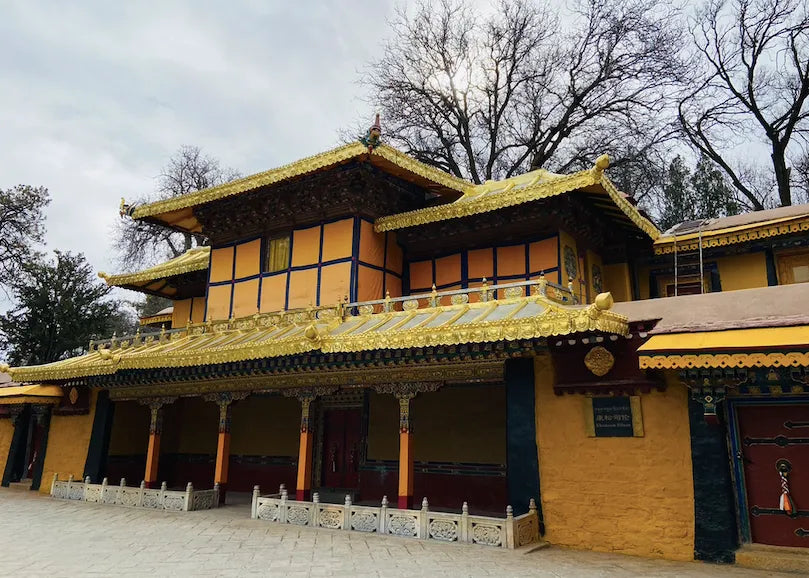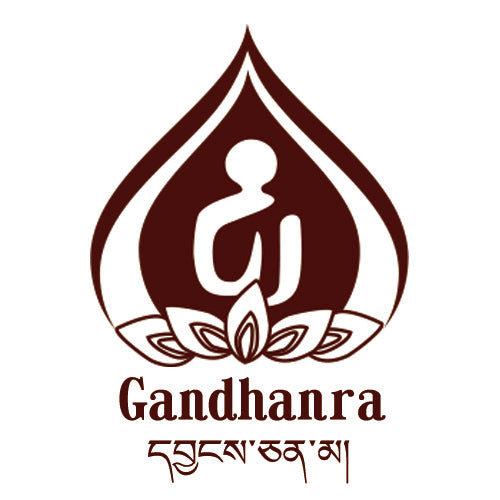
Roblinka - Garden of the Gods


The center of government and education in the supreme palace,
Where subjects and citizens enjoy the same happiness in the lower palace.
Ralungpa Losang Pemo(ལྷ་ལུང་པ་བློ་བཟང་ཕུན་ཚོགས་;1926-2008).
It is important to note that the term "Ralungba" (ནོར་བུ་གླིང་ག་), often translated as "Garden of Treasures," is simply a colloquial name used by the citizens and urban nobility of Lhasa to refer to this architectural complex (emphasizing its function as a garden). In early official records, this complex was referred to as the "Lower Palace" or "Summer Palace" (དབྱར་གསོལ་ཕོ་བྲང་). Generally, the Dalai Lama leaves the Potala Palace to go to Ralungba around the 18th day of the third month of the Tibetan calendar, and returns to the Potala Palace around September.
The "Supreme Two Dharmas" possessed by each of the Upper and Lower Palaces refer to the dual symbolic significance of the Potala Palace and Ralungba in Lhasa (and the Tibetan region). Firstly, as the residence of the Dalai Lama, both places are considered worldly symbols of the Pure Land of Avalokiteshvara. Secondly, the two palaces have their unique positions: the Potala Palace is the center of political and religious power, while Ralungba is the birthplace of the "trusted politics" of the Ganden Phodrang regime (1642-1959), known as the principle of "no distinction between ruler and subjects".

Today's Potala Palace can be divided into five core architectural complexes:
Red Star: Ganden Phodrang Palace Complex(བསྐལ་བཟང་ཕོ་བྲང་)
Blue Star: Lhalu Lake Palace Complex(མཚོ་དཀྱིལ་ཕོ་བྲང་)
Yellow Star: Chakpori Palace Complex(སྤྱན་བསལ་ཕོ་བྲང་)
Purple Star: Reting Monastery Palace(རྟག་བརྟན་མི་འགྱུར་ཕོ་བྲང་)
Brown Star: Shugden Temple Complex(ཞབས་བརྟན་ལྷ་ཁང་)



Interior of Kangsongsi Lunge in Tibet
Seen in "Tibetan Architecture"


Belonging to the Huxin Palace architectural complex, this palace is named "Kang Le Ju Zhong Xi Palace" (བདེ་སྐྱིད་ཀུན་དགའ་འཁྱིལ་བའི་ཕོ་བྲང་). It was initially built during the reign of the Eighth Rinpoche, and later expanded by the Thirteenth Rinpoche. Symbolizing the inner palace of the Pure Land of Guanyin.




Also known as "New Palace" (Pho-Drang Sarpa),
is the core sleeping chamber of the Fourteenth Dalai Lama.
The palace is named after the eminent scholar of the Third Chikang Rinpoche
(Khri-Byang Rin-Po-Che: 1901-1981).
Combining Tibetan, Chinese, and English styles, the palace and gardens offer a unique blend of cultures.

The mural depicts a partial image of Tibetan King Trisong Detsen obtaining the "mysterious divine object" at Yumbulagang.
The inscription on the mural reads: "After five generations, there will be a person who understands the meaning."
The "person who understands the meaning" here refers to Songtsen Gampo.
Thirty years of great changes
 "Panorama of Lhasa", 19th century, Royal Ontario Museum
"Panorama of Lhasa", 19th century, Royal Ontario Museum

During this war, the Seventh Dalai Lama and his father, Sangye Tashi (whose wife at the time was the daughter of a U-Tsang minister), secretly supported the U-Tsang nobility. Despite both the Seventh Dalai Lama and the Fifth Panchen Lama calling for peace negotiations between the warring factions, little progress was made. Sangye Tashi also made several attempts to stall the conflict under the pretext of ceasefire negotiations to buy time for the U-Tsang nobles. However, the tables turned when the initially weaker Kham forces grew stronger and pushed back the U-Tsang forces, forcing the three U-Tsang ministers to seek refuge in the Potala Palace and request the Seventh Dalai Lama's protection.

Jacques Marchais Museum of Tibetan Art
In order to save the lives of the three former rulers of Central Tibet, the Seventh Dalai Lama sent a representative willing to vouch for them. Palden Lhawang Bosoe Namtok Gyatsas temporarily promised not to harm the three former rulers of Central Tibet and to preserve their properties, but under the condition that they must be under his supervision. In June of the same year (1728), Palden Lhawang Bosoe Namtok Gyatsas paid a visit to the Dalai Lama in the palace and promised to maintain a pure relationship of offering and receiving alms in the future (while the Seventh Dalai Lama's power declined).
When the representative of the Qing Emperor arrived in Lhasa, the three men from Central Tibet and their supporters were beheaded, and the Dalai Lama and his father were sent back to their hometown of Lithang (later relocated to Huian Monastery in Taining). Thus, the ruling power in Tibet was officially under the control of Palden Lhawang Bosoe Namtok Gyatsas, officially starting the "era of the Tibetan kings" (མི་དབང་མཆོག་གི་དུས་སྐབས་;1728-1750). For the artistic representations of the "Tibetan royal family," please refer to the previous article.

Jacques Marchais Tibetan Art Museum

Ngawang Chodan (ངག་དབང་མཆོག་ལྡན་; 1677-1751) was the teacher of the Seventh Dalai Lama during his time away from Lhasa. He belonged to the Reting Monastery lineage, just like the Seventh Dalai Lama. Ngawang Chodan was an early confidante of the Seventh Dalai Lama and was responsible for maintaining his connection with the three major monasteries in Lhasa.
Unlike the previous trip to Lhasa, the return in 1735 was a journey full of agony for the Seventh Dalai Lama. The military and political power in Tibet was still held by the Tibetan king, with the Seventh Dalai Lama only given nominal authority to manage religious affairs. Struggling with frequent rheumatism and headaches (believed to be superficial manifestations of the robbing karma), the Seventh Dalai Lama, secluded in the Potala Palace, had to rely on trusted allies (some former Tibetan nobles and monks from the three major monasteries) to keep track of the movements of the Lhasa government.
In 1747, the renowned Tibetan king, Polane, passed away. His second son, Gyurme Namgyal, succeeded him as the new king. This heir, described in Tibetan noble records as a man with a history of "misdeeds", was assassinated in 1750 during a series of political struggles by a Qing dynasty official stationed in Tibet.


In the origin story of Roblinka, all three parties behind the power shift were prominently featured. In order to provide a better place for the Seventh Dalai Lama, who had long been suffering from illness, government officials and representatives of the Qing Dynasty, together with the Potala Palace, built a simple palace called "Imperial Tent Palace" at the "Shrub Garden," where the Fifth Dalai Lama had once visited for the summer retreat. In 1755, a grand palace was built with Tibetan garden features, known as the Roblinka, named after the Seventh Dalai Lama. Thus, with His Holiness residing in the garden, accompanied by his loyal followers and embraced by officials, the people of Lhasa gradually shifted their attention to this sleeping palace and garden in the southwest corner of the city.


Bring the crowd into the park.
 The panoramic view of Potala Palace (mural)
The panoramic view of Potala Palace (mural)As seen in the "Architectural Art Series of Tibet: Potala Palace"

After more than thirty years of ups and downs in the world, the Seventh Dalai Lama passed away in 1757. By the time of his passing, the trusted political and Qing dynasty forces had completely controlled the political and religious affairs in the Tibetan region. For the Eighth Dalai Lama, Jampel Gyatso (1758-1804), he no longer needed to focus on political affairs like the Fifth Dalai Lama.
Throughout his life, the Eighth Dalai Lama maintained the identity of a devout religious practitioner, largely due to his fragile health. He often made decisive decisions between regents and officials using his network of trusted followers. During his reign, conflicts often arose between his trusted followers and government officials, leading to the expulsion of some key followers from the Potala Palace.
For the Eighth Dalai Lama, the Potala Palace seemed to hold a greater attraction than the Jokhang Temple. During his reign, the Potala Palace was continuously expanded and eventually developed into a complete architectural complex. The unique water features of the Potala Palace provided an excellent space for meditation for the Eighth Dalai Lama, who was deeply devoted to tantric practices.
As a result, he undertook a series of expansion projects, including the construction of the Lake Palace area as the second architectural complex of the Potala Palace. Throughout the succession of the Dalai Lamas, the Potala Palace has continued to serve as a place for the Dalai Lamas to study and live. Among the Three Great Monasteries, the Potala Palace has been given the nickname "Garden Guru"(གླིང་ཚལ་བླ་མ་), referring to the teachers who enter the palace gardens to instruct the Dalai Lama.

Seen in "Tibetan Architectural Art Series: Norbulingka"

Elevation of the Lhasa Potala Palace, as seen in "Tibetan Architectural Art"
Among the lineage of elders in the past, it was the Thirteenth Dalai Lama, Thupten Gyatso (ཐུབ་བསྟན་རྒྱ་མཚོ་; 1876-1933) who truly maximized the political connection between Lhasa and his trusted officials. This ambitious leader sought to create a private space solely for himself, and in 1922, the Thirteenth Dalai Lama began the expansion of the garden area of the Potala Palace (known as the Norbulingka; the Precious Garden) and oversaw the construction of his own sleeping quarters.
Originally built in a South Asian style, this sleeping quarters was rebuilt due to design issues and became the present-day Norbulingka Palace (constructed between 1926-1929). With this, the Potala Palace was officially divided into two areas: the eastern side with the Potala Palace complex at its center, and the western side with the Norbulingka Palace complex at its center.


"In the summer corner, the attendant
Should be in contemplation and meditation,
The attendant's sedan chair
But in the summer palace, eating grass."

as seen in "Tibetan Architectural Art Series: The Potala Palace"


This sacred garden, which has a history of nearly three hundred years, is constructed unlike traditional Chinese gardens with "winding paths leading to secluded spots" or Mughal gardens with "surrounding palaces fit for kings." The Norbulingka draws inspiration from Tibetan gardens (temple gardens - manor gardens - castle gardens) and also incorporates elements from Han Chinese, South Asian, and Western garden art.
In terms of vegetation, the emphasis is on the coexistence of ornamental and medicinal plants, with a green coverage of eighty percent, planned in a way that mirrors the ideal world of Buddhism. In terms of architectural layout, the buildings are separated yet unified aesthetically, reflecting the concept of power presentation in connection with the paradise for sentient beings. Lastly, in terms of garden decoration and palace facilities, the "palatial style" that has been prominent since the establishment of the Ganden Phodrang (represented by the Snow Palace and the Court Painting Institute) is highlighted, with attention to detail showcasing a diverse cultural and artistic philosophy. As described by Ando Geshé Dandul Shépai LodröPel, who visited the Thirteenth Dalai Lama at Norbulingka in 1932: "This is a rare and magnificent garden of pure delight rarely seen in the world."

